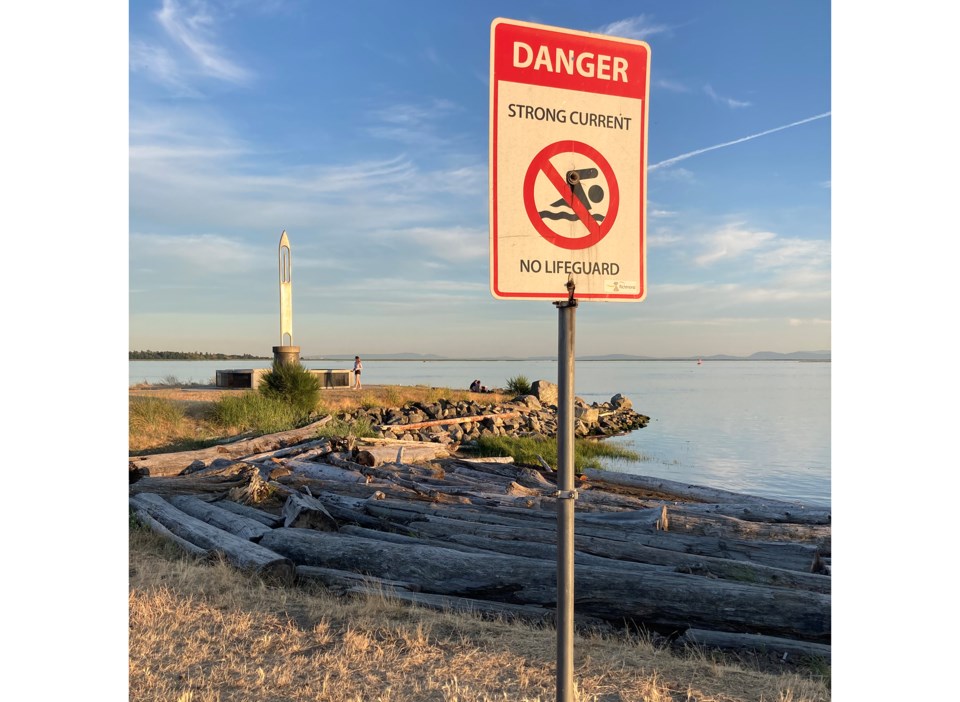Only a handful of signs have been erected around Richmond’s shores warning of the dangers of one of the province’s “deadliest” rivers – not nearly enough to help save lives, according to one local teacher.
Michael Taylor – who is also calling on the Ministry of Education to amend the physical education curriculum to include water safety education – said he felt compelled to take action after learning how little his friends and students know about water safety.
“The Fraser River is the deadliest river in this province – it can appear calm and accessible in some areas but the water current is very dangerous and the public should be aware of that.”
The Hugh Boyd Secondary teacher – who recently wrote an op-ed on the issue, published in the Vancouver Sun – said he has travelled around Richmond in search of signage along the Fraser River, but was unable to find any apart from three small signs at Garry Point and one sign at London Landing, near the end of No. 2 Road in Steveston.
He told the Richmond News that he hasn’t seen any signs in “high traffic” regions around the city, such as along Steveston Village’s walkways and piers, the Dyke Trail or River Road, or around the docks behind the Pacific Gateway Hotel.
It was near the Pacific Gateway Hotel that 24-year-old UBC athlete and Hugh Boyd Secondary alumnus Kory Nagata lost his life last summer while attempting to retrieve a football that had fallen into the water.
Taylor, who teaches at Hugh Boyd, said he didn’t know Nagata personally. He said he wanted to take action after realizing that water safety doesn’t seem to be common knowledge for many.
It’s not just a lack of signage that Taylor has noticed. Apart from a couple of “smaller, more basic” life-rings at a few private marinas, he said he hasn’t found any publicly-accessible life-rings in Richmond.
However, City of Richmond spokesperson Clay Adams told the News that signage is in place where people go kayaking or boating, warning of currents and the need for lifejackets, such as at London and Imperial landings, as well as McDonald Beach. Signage at Garry Point warns against swimming, as do signs at the London Landing boat launch.
Adams added that there are four emergency life-rings at Imperial Landing, as well as waterside safety ladders in case of accidental falls. Similar measures are in place at Britannia Shipyards.
According to data from the BC Coroners Service, over 660 people fatally drowned in B.C. waterways between 2008 and 2016 – many during the summer months. During that period, 19 to 29-year-olds made up the largest proportion of the accidental drowning deaths, followed by 50 to 59-year olds.
The data also states that 32 people lost their lives in the Fraser River between 2008 and 2016 – more than any other river or creek in B.C. Meanwhile, the Okanagan Lake had the highest number of deaths – 24 – out of all lakes and ponds.
Dangers of the river
Around Richmond, the Fraser River is particularly unpredictable due to fresh water mixing with sea water, in an estuary that runs up to near Coquitlam, Aaron Harnden, station leader for volunteer-run Royal Canadian Marine Search and Rescue, told the News last year.
“So there are undertows in between those different portions of water, as well as eddies and backflows depending on where you are in the river, and that’s what makes it so unpredictable,” he said at the time, adding standing waves can also be created during tidal processes.
Taylor said he’s advocated to several city councillors and the mayor’s office to put up more signage and life-rings near Richmond’s waterways. He added he doesn't think the size, placement and number of existing signs in Richmond is “sufficient enough to emphasize the dangers” of the river.
While signs aren’t a panacea, he said they do promote awareness of swimming dangers, and are easy to implement and cost-effective.
“There is no good reason why more swimming danger signs are not erected along our city shores. We as a community have a moral imperative to take these simple, basic measures to save lives.”
Curriculum could be updated
But it’s not just Richmond that could do more to reduce drowning fatalities, said Taylor.
There’s a “missed opportunity” for schools to promote water safety, such as through presentations or teaching components in the high school curriculum.
Taylor said that while conversations around what should be emphasized in the curriculum focus on a variety of topics, such as sexual exploitation, addiction, or drunk driving, there doesn’t seem to be any focus on drowning.
He said he’s reached out to the Ministry of Education, suggesting they make “simple amendments to include language around water safety education” in the high school physical education curriculum.
Currently, that curriculum includes “open-ended” language outlining basic principles for responding to emergencies, such as following safety guidelines or having an emergency response plan, he said.
“It just broadly gives teachers the ability, if they so wanted, to incorporate water safety education, but it’s not referenced and therefore I don’t think it’s…on the top of educators’ minds, so I don’t think they would teach it,” he said.
Taylor has also reached out to school districts across Metro Vancouver to advocate for water safety education.



